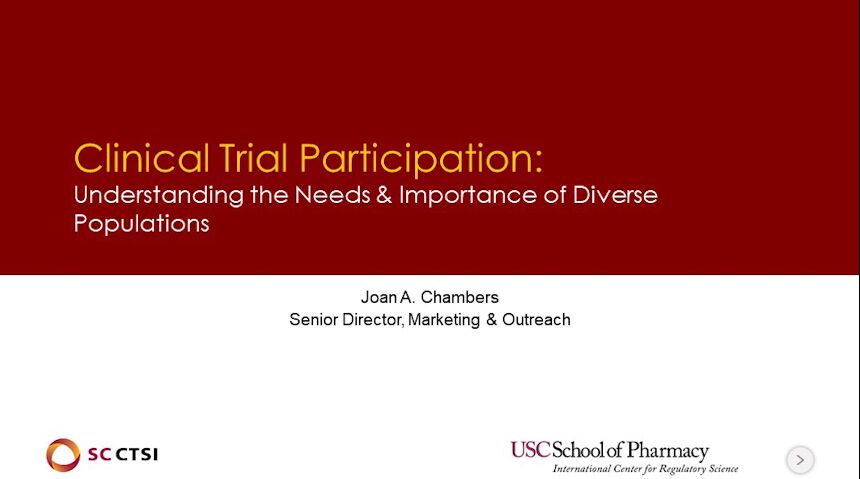1. Journey on Clinical Trial Participation
a. Decision Making, Participation Challenges, Convenience Enhancing Technologies & Support, Additional Direct-to-Patient (DtP) Considerations
2. Discussion Areas Through the Journey
3. Current State
a. Wide acknowledge that disparities exist in CTs and beyond
b. Industry have collaborated with patient advocacy groups to regain trust and bridge gaps of communication
c. Broadening eligibility criteria to reflect the users of the drug or market, after market-approval by FDA
4. Importance of Clinical Trial Research
a. FDA is looking at broadening eligibility criteria to ensure adequate representation and studies for all ages and groups
b. CISCRP Campaigns: Diseases don’t discriminate. Diversity in CTs bring new treatments to everyone
5. Deciding to Participate
6. Willingness to Participate Does Not Always Translate into Participation
a. Lack of understanding, of being informed, or not having a physician referral, concerns or fears of participating
7. Black and Hispanic Populations More Confident in Knowledge, Asians Least Confident
a. How well do you understand what is meant by the term “clinical research study”?
8. Mistrust of Pharma Companies Issue Among Both White and Black Populations
9. Clinical Trials Not Often Considered in Health Care Providers (HCP) Discussions but Patients can Advocate for Clinical Trials
a. Patients often ask their primary care providers (PCP) for CTs but PCPs may not be familiar with currently available CTs
b. Patients actually are more confident in persuading PCPs for CTs
10. HCP Advice and Involvement Impact Willingness to Participate, Particularly Among Black Population
11. However, Most Have Never Been Asked to Participate
12. Important Participation Considerations
a. Concierge services i.e. transportation or lunches were important elements in these communities
b. Study information being available to patients was important
c. Mobile applications
13. Key Information for Participation Decision
14. Top Participation Barriers Include Logistical Concerns
a. Motivations
i. Advance science/treatments
ii. Help others with my disease (altruism)
iii. Better treatment
iv. Education about disease/treatment
v. Access to healthcare providers
vi. Free medication/treatment
vii. Information about the study influenced
b. Barriers
i. Not wanting to risk health
ii. Risks involved
iii. Not knowing enough
iv. Do not want to be treated as a test subject
v. Risk of placebo
vi. Too much time required
vii. Cannot afford time off
viii. Too difficult to get to the research center
c. Those over 65 are highly motivated for advanced science and better treatments for their conditions
15. Participation in COVID-19 Clinical Trials
16. Concerns in Participating COVID-19 Clinical Trials
a. Top Concerns: Risk of Placebo, Do not know enough about research, Do not want to take chance on health, Risks of CTs
17. Awareness of COVID-19 CTs
a. 27% identified COVID-19 CTs via traditional advertising
b. 12% identified COVID-19 CTs via social media
18. Seeking Advice When Deciding to Participate
a. People are more willing to participate if their PCP or specialist is conducting this CT or is heavily involved with CT
19. Receiving Information After Completing Study Participation
a. Patient engagement after the study is also important!
b. 68% wanted a summary of study results
c. Participants want to know how their participation contributed to these findings
d. Older age groups wanted to see their patient summaries if they received placebo more so than in the younger age groups
20. Preferences on Delivery of Clinical Trial Results
a. An emailed summary is the most popular choice, with the second option is a mailed, printed summary
b. Asian and Hispanics wanted to receive information via advocacy groups or webinars more so than other racial groups
21. Participation Challenges
22. Participation for the Duration of the Study Depends on Several Factors
a. Patient retention challenges: side effects of study drug, location of study, poor communication with study, burdensome time commitment, no longer qualified due to eligibility criteria
23. Travel, Length of Visits, Diagnostic Tests Among Top Burdens
24. Convenience Enhancing Technologies and Support
25. Areas of Growth in the Use of Convenience Enhancing Solutions Since 2017
26. Participation in a Clinical Research Study May Require the Use of Smartphones
a. Older generations want separate smartphones and keep CT separate from their own phone
b. Younger generations prefer using their own phones
27. Most Children Used Smartphones and Other Technology During Participation
28. Study Volunteer Experiences are Improved with Supportive Services and Technology
29. Current Clinical Trial Implications
a. COVID-19 pandemic has caused studies to be placed on hold, increased virtual visits, increased use of smartphone apps and patient engagement via technology mediums
30. Additional Direct to Patient Considerations
31. Which Model is Most Appealing? No One Size Fits All
32. No One Size Fits All: Diverse Communities
33. Investigational Medication Administration Methods
a. Pre-packaged medicine is easier to administer
34. Medication: Ease of Use and Understanding of Instructions
a. Questions on how to properly dispose medication and its containers i.e. vial, syringe
35. Technology Advancements Impacting Clinical Research
36. Key Take-Aways
a. Patients want and need the support
b. Impact to daily life is critical for patients considering CTs
c. COVID-19 pandemic has increased the use of technology in CT development
d. Industry needs to go to where the patients are, so how do we strategize how to meet the safety measures for the patient and the study?
37. COVID-19 Impact on the Clinical Research Industry
a. Renewed interest in vaccines
b. More adoption of artificial intelligence i.e. wearables
c. No one size will fit all; some studies will need to be hybrid model vs. others can solely be virtual
38. Path Forward
a. Education and engaging clinicians on CTs will contribute to more patient participation in CTs
b. Leveraging technology in CT development
39. Clinical Research Educational Resources
40. Thank You
a. CISCRP Resources can be found here: https://www.ciscrp.org/educati...
41. Questions
a. How old are survey takers? They ranged from the ages of late 20s to 65+
b. Do you still think there are trust issues in CT research among certain groups? Is it getting better or worsening? There is a high level of concern and lack of trust. Industry stakeholders need to embrace this new diversity guidance, develop strategies and initiatives to rebuild this trust
c. Informing these diverse communities especially on the safety measures in place
d. There is a lot of historical mistrust to overcome!
e. Role of technology during this pandemic in CT process? Tech in the CT landscape will be more and more embraced over time.
Regulatory Science Symposium: Diversity in Clinical Trials in the Time of COVID-19 Session 4: Clinical Trials Participation: Understanding the Needs and Importance of Diverse Populations
Research & Study Design
Regulatory & Quality Sciences
Joan Chambers, B.S.
Senior Director for Marketing and Outreach, Center for Information and Study on the Clinical Research Participation, B.S. in Marketing
Course Syllabus/Topics
Acknowledgement
Accompanying text created by Annie Ly | Graduate Student, Regulatory Science, USC School of Pharmacy lyannie@usc.edu

